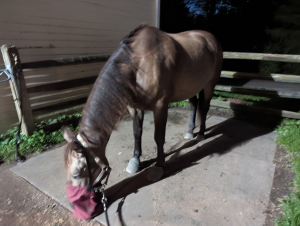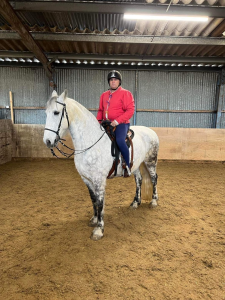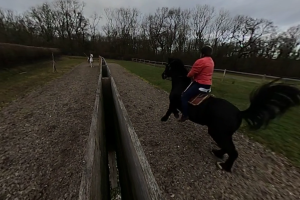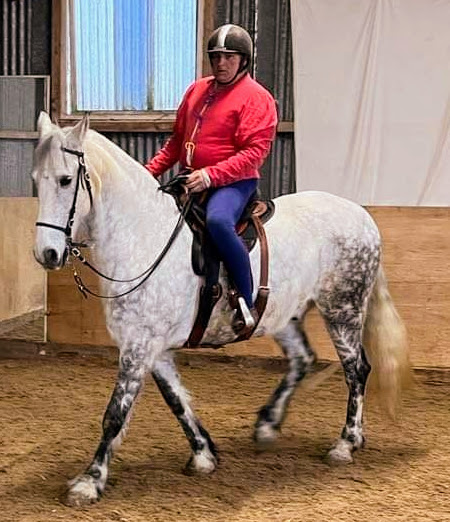The very word, “chivalry” comes from the French “cheval”, meaning “horse”. From the very beginning of chivalry and knighthood, horses and riding them have been at the base of what we do.

[T]he art of being a good horseman is one of the main skills necessary to knights and squires…
King Dom Eduarte 1 of Portugal (b.l391-d.l438) “LIVRO DA ENSINANQA DE BEM
CAVALGAR TODA SELA (The Art of Riding on Every Saddle)” Translated by Antonio Franco Prcto, Edited By Steven Muhlberger
In my own pursuit of chivalry in the modern world, I have been taking lessons in horse riding since late 2000. I am extremely grateful for the insights I get almost every week from the people (and especially Stacy Quinn) at Mack Hill Riding Academy and to Dominic Sewell of Historic Equitation who taught me a lot in the short, but information-packed time I had at Historic Equitation when I visited there in February 2023.

At the moment, I have a weekly one hour class at Mack Hill, where I am learning the basics of equitation – how to groom and tack the horse, ground work walking, trotting, cantering, and some simple obstacle courses and low jumping. Because I’m in the last lesson group of the day, I also get to feed dinner to the horse I train with, before walking him back to his paddock. I’m happy I get somewhat more than an hour with the horses I ride, and also to interact with a little more than just riding.
Equitation, important for knights in ages past, teaches us many important life lessons. The obvious one is that a horse, being much more powerful than a human, cannot be simply commanded. We learn quickly how to work with these magnificent creatures, as partners. We learn give and take, how to take good care of our training partner while they take care of us. Horses, being herd animals, get scared or spooked easily and tend to follow the rest of the herd. We learn how to deal with that, to be calm and collected in all situations, to be the leader the horse needs and wants.
Once in the saddle, we learn how important body posture is to communication with the horse – the position of your hands, the curve of your spine, the pressure of your knees, and of course, the contact with your feet and heels all conspire to become a set of communication tools with the horse. There are a lot of things to be aware of, which, over time, become second nature.
And the horse also talks to you in a myriad of subtle (and some less subtle) ways. Tabasco, the horse I most often ride these days, likes to break into a trot from a walk without being asked to do so. At first this was a bit startling, but now, it is almost like we read each other’s minds. I can feel the muscles tighten just a little and his head bobs up. The longer I learn, the more subtleties I pick up on. Some horse people will tell you there is a psychic connection between horse and rider. Whether this is literally true or if the myriad of subtle communication cues combine to seem like magic, it all works the same. If you don’t know the subtle cues, but work as if there is a psychic bond, it works. Beyond Tabasco’s own propensity to trot when he is supposed to walk, I find that if we are walking and I think to myself, “I’ll ask for a troy at this point a couple dozen feet ahead,” Tabasco seems to pick up on it and breaks into a trot right away. This can lead to some odd words coming out of my mouth along the lines of, “Tabasco! Stop reading my mind and wait for my leg signal!”

In any case, there is a very strong bond that forms between horse and rider. Every horse is different and has their own personality, just like people. Some people you work well with. Others… not so much. Riding helps you learn to work with different personalities.
Additionally, the horse needs to learn as much as the rider does. Some horses are more skilled in some areas than others. Some may have been taught to pull a cart but not to have a rider in a saddle. What you’ll hear called “school horses” tend to be the more calm personalities trained to take an unskilled rider. At Mack Hill, I’ve ridden several horses as I developed my own skills. Bo and Louis were pretty calm and understanding. Tahoe was a fantastic steed I wish I spent more time with. Sam is a handful and very Puckish. He loves pushing peoples’ buttons and causing mischief. Tabasco, like me, began serious training a little later in life (ok, not as late as me), so he has some bad habits we are working on. He doesn’t like taking direction from anyone but he comes around when he realizes I’m not letting him get away with doing his own thing. We are both learning the teamwork thing.

In February I had the opportunity to travel to England for an armored fighter clinic. While that itself was absolutely incredible, the event took place at Historic Equitation and I arrived a day early and managed to get a lesson from Dominic Sewell, who runs the facility. My goal was to experience the feel of a (reproduction) 15th century jousting saddle (and tack). Dom started me out Apollo, on a larger gelding with an Australian saddle. The saddle is a modern working saddle that vaguely resembles medieval saddles. After a short ride on Apollo for Dom to assess my ability level (Apollo is a remarkably gentle giant…) we took a lunch break. Dom’s hospitality was above and beyond.
After lunch, Dom tacked up Esteban, an amazing Friesian cross stallion. Esteban might look familiar if you are a fan of historic jousting in England and Europe. We used a reproduction 15th century jousting saddle with a curb bit and a very interesting pair of stirrups that I absolutely love. The stirrups were kind of conical, so they slightly hugged my toes but couldn’t allow my foot to slip through. They worked perfectly with the turnshoes I was wearing.

After a brief warm up in the indoor arena, we moved outside to the tilt yard, where Dom talked me through several passes along the barrier, many with Clive Hart riding the other side as my opponent. I was amazed at the power and control Esteban had. It felt more like I was riding a rocket than a horse. He went from zero to full speed in about 2 strides. I am happy I got the whole lesson on 360 video because Dom gave me so many extremely useful pointers that I continue to review and use today.
I think anyone who aspires towards a life of chivalry in the modern age would do well to learn to ride horses. The connection between cavalry and chivalry goes deeper than their origins and the linguistic connections. The connection is integral to their very essence. It doesn’t matter if you think you might be too old. Find a good barn and learn to ride. You’ll be glad you did.
